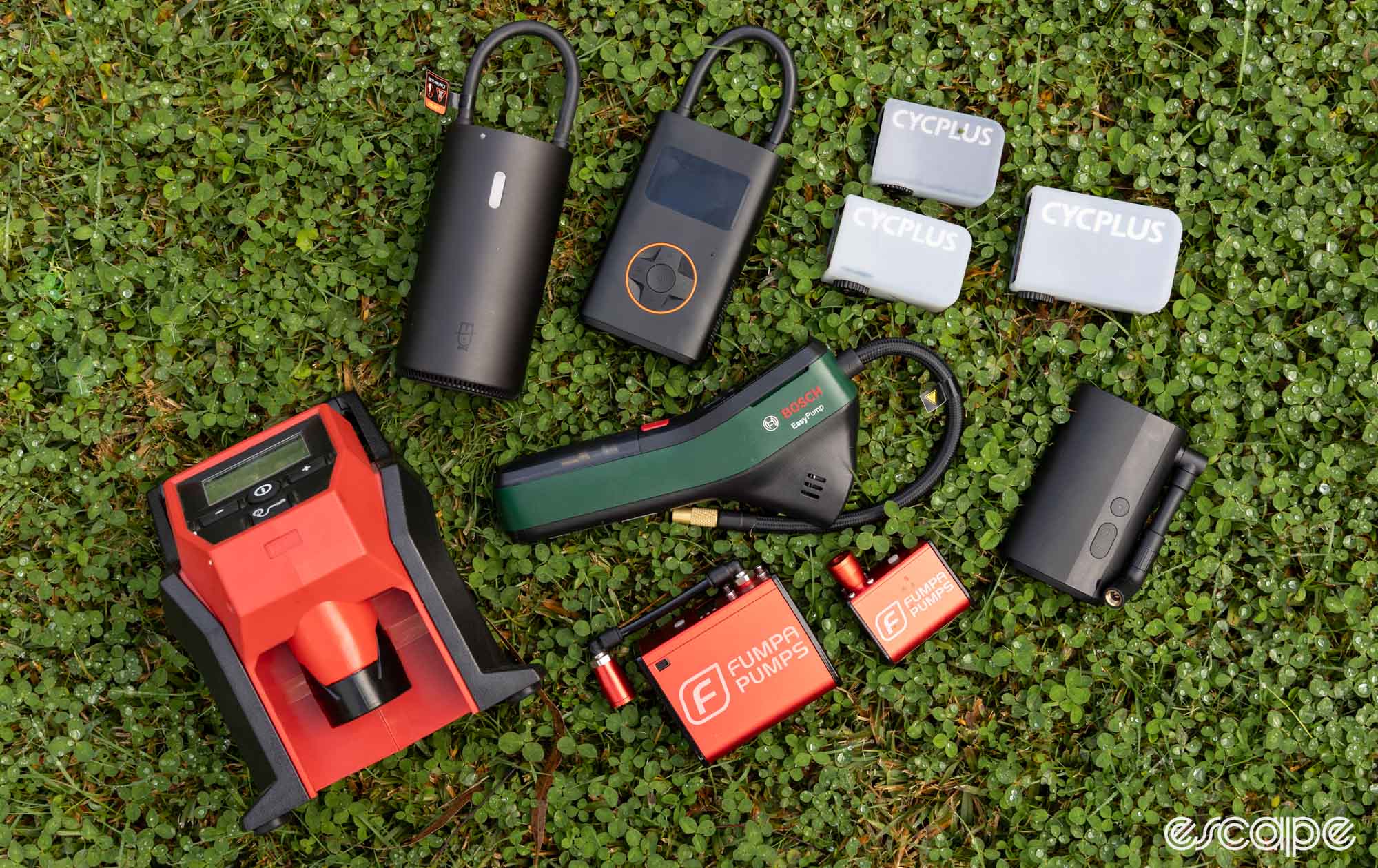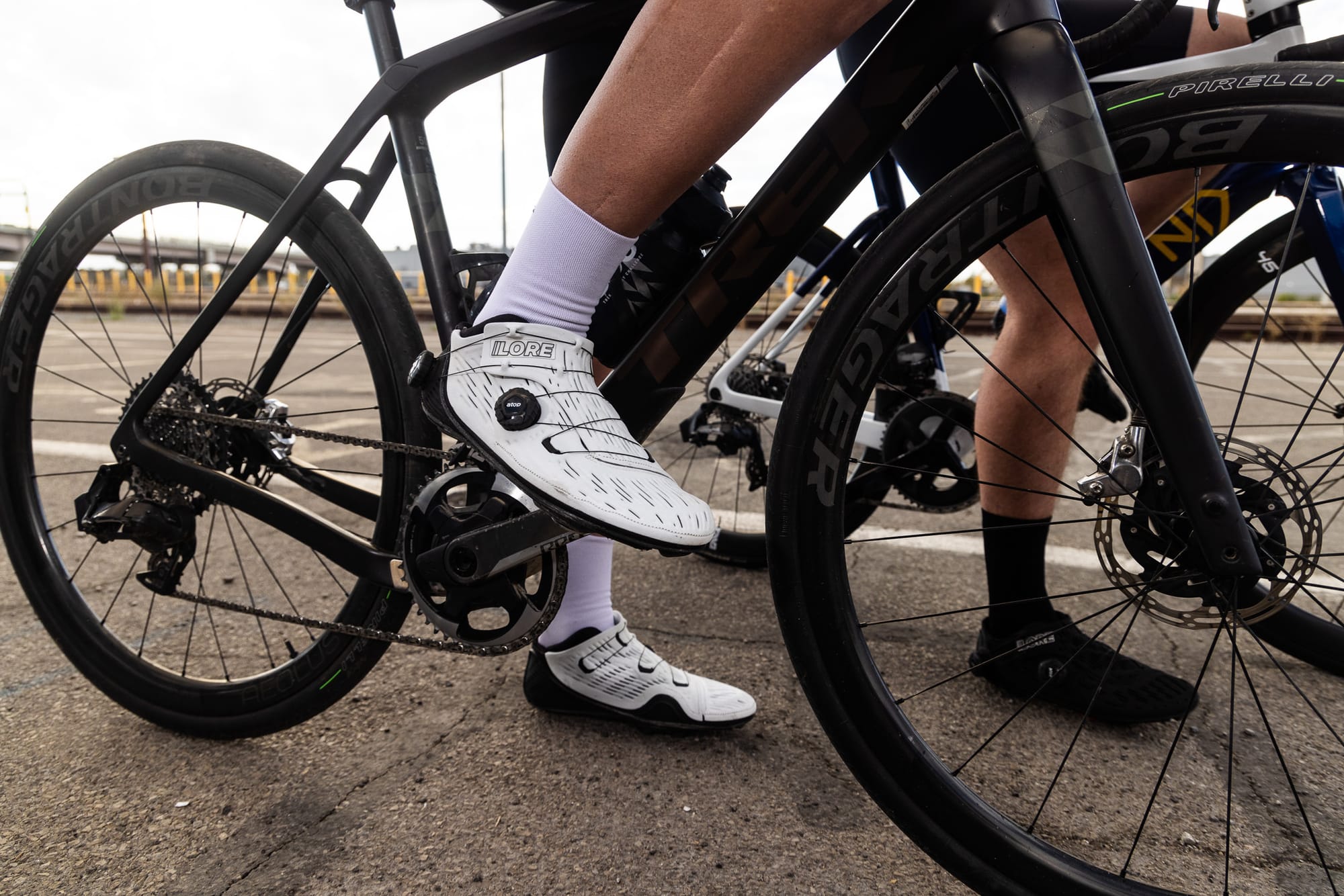Today, most keen cyclists are more aware of the importance and benefits of accurate tyre pressures than ever before. Add in increasing tyre volumes and faster pressure loss from tubeless and you have a list of reasons to own a decent pump with a trustworthy pressure gauge.
While floor pumps, air compressors, mini hand pumps, CO2 inflators, and dedicated pressure gauges continue to hold their respective places in the market with little innovation, the category of battery-powered electric inflators has quickly gone from underground to widespread. Now, with the simple push of a button from a hand-held device you can check and top up your pressures or effortlessly fill a flat tyre.
I’ve been actively testing and reviewing products in this category for over a decade (this may be my sixth written review on the subject?), and it’s safe to say that I’ve become a fan of some of these inflators that, in the simplest sense, could be viewed as pressure gauges that inflate.
Long promised and a few days late (we didn’t want this buried in all the amazing TDFF coverage), this edition of Threaded examines the current and rapidly changing state of portable electric tyre inflators. I’ll compare a handful of popular options, discuss what I consider to be important features, and share what should be known. I’ve tried to keep this one brief, but there are a lot of thoughts to air.
Defining size and purpose
Electric tyre inflators are nothing new – even more than 15 years ago you’d hear the buzz of pressures being adjusted in the grassy paddocks of cyclocross races. However, those older inflators were commonly based on the form factor and battery of a drill, and so while decently compact, they were never something you’d consider taking with you on a ride, putting in the glovebox of a car, or stashing in a suitcase.
That all changed when Australian company Fumpa launched. It brought the first cycling-specific tyre inflator to market and was quick to further miniaturise its designs for carrying on rides. Fumpa’s success in recent years has seen a number of new entrants hit the market, and in turn, several sub-categories of electric tyre inflators now exist. With this, I see the electric tyre inflator category as fitting into four segments.
At the smallest and most-cute end of the scale, there’s the newest and trendiest category of ride-friendly emergency inflators that are intended to replace a frame pump, mini pump, or CO2 inflator. They’re small and light to be stashed in a saddle bag or riding pack, and they offer a comparable inflation capacity to two 16 gram CO2 cylinders. Starting with the Nano and Mini Fumpas, this category of mini inflators initially lacked a pressure gauge, but we’re now seeing that change with the latest from the likes of Cycplus and RockBros.
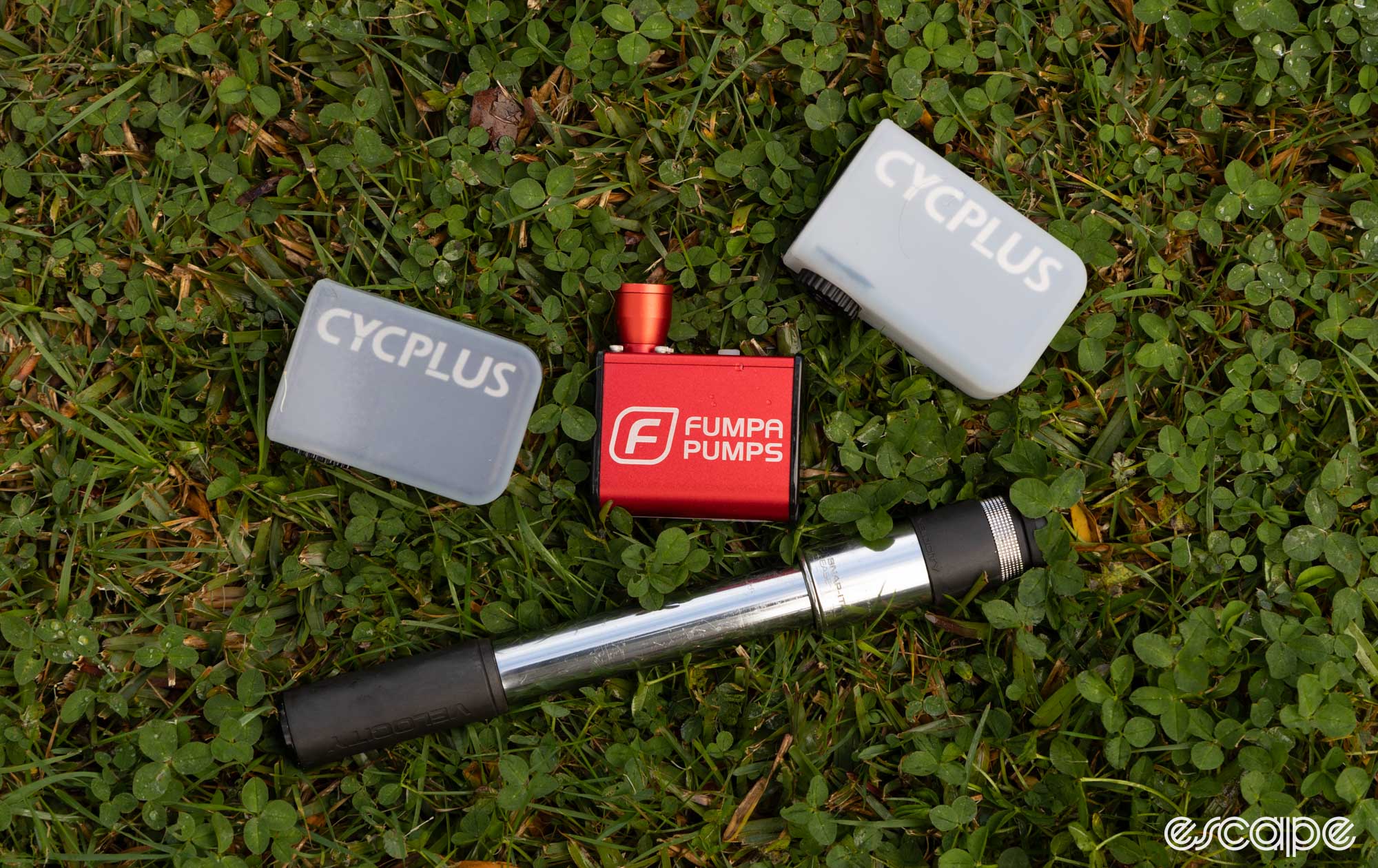
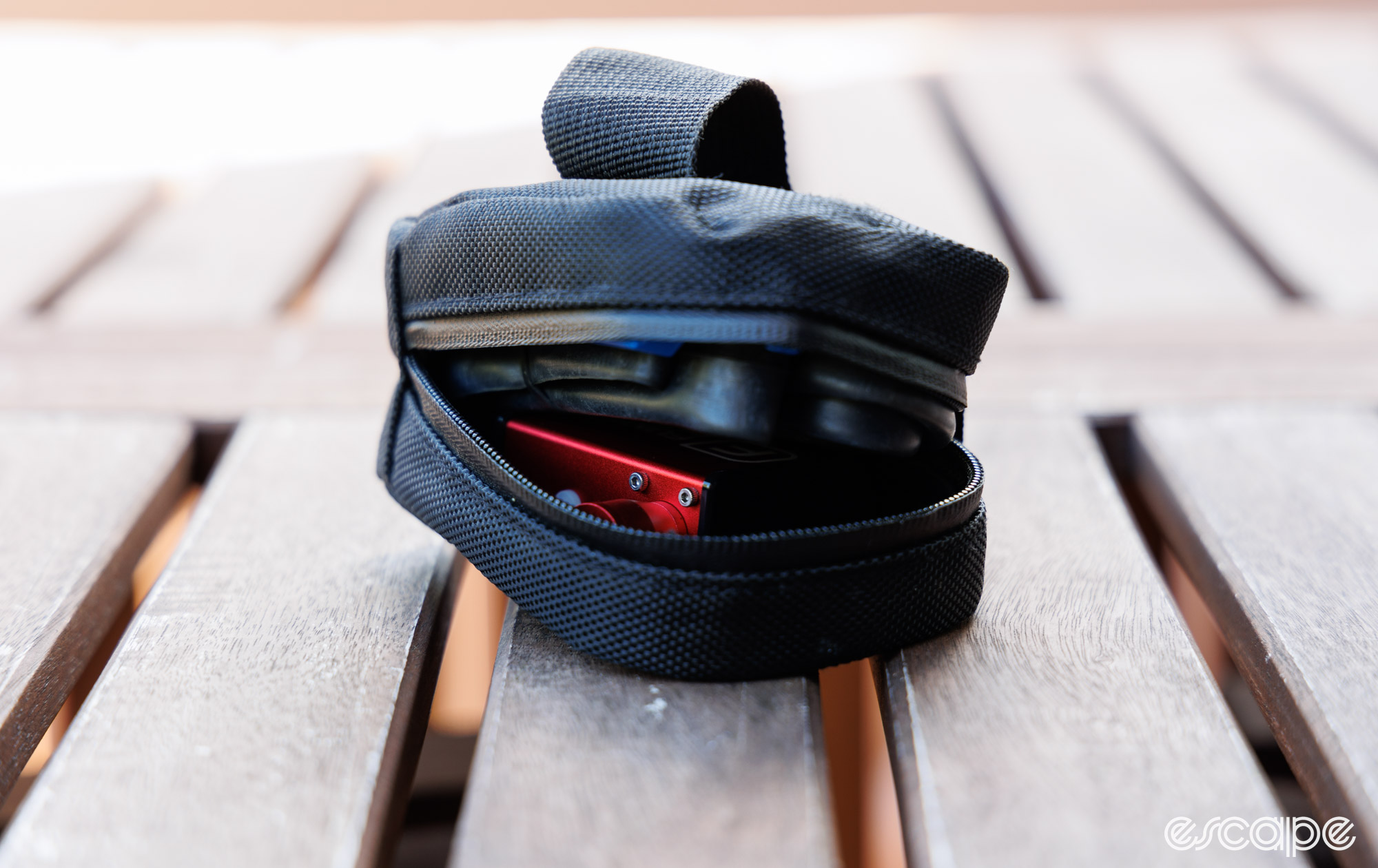
The most saturated and arguably most mature segment is that of small to medium-size inflators. For bicycles, these inflators are effectively competition to the humble floor (aka track) pump and are best used to top up and check pressures before the ride. It’s also a fantastic option as something compact and portable to leave in the car or take on a holiday. Some riders also happily carry some of the smaller inflators on rides (such as the original Fumpa or QiCycle Mini), but I find them too weighty for that. Meanwhile, the medium-size inflators, such as the Bosch Easypump or QiCycle N3, are typically less cycling-specific in intended purpose, but will certainly inflate a bunch of bicycle tyres without fuss.
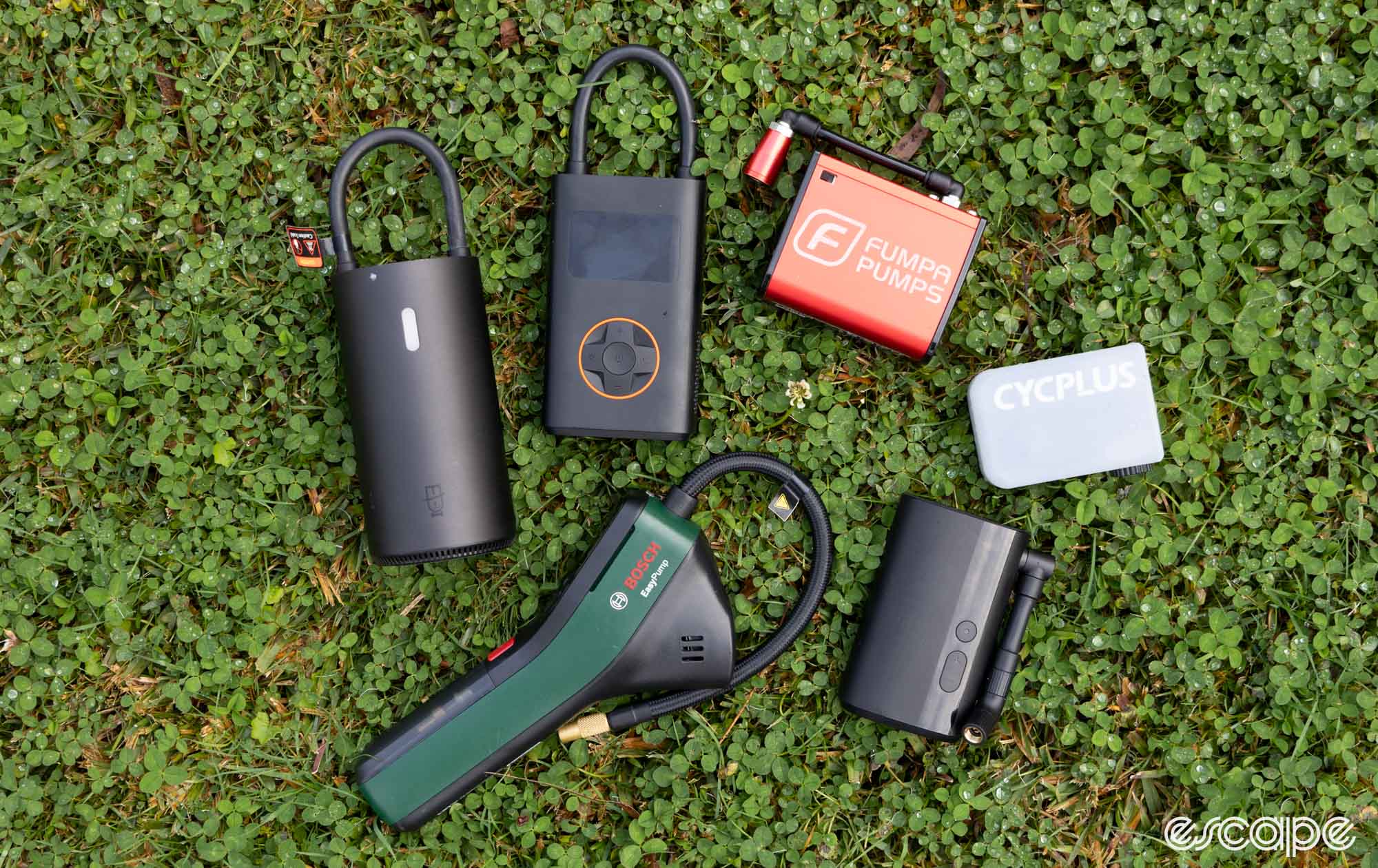
Lastly, and not a category of focus in this edition of Threaded, are the larger automotive tyre inflators that have the battery capacity to fill a car tyre (or four) or be configured for bulk bicycle tyre inflations. Most of these are available through mass-market power tool brands (such as Milwaukee, Makita, Ryobi, etc.) and repurpose the rechargeable batteries of those respective tool lines. You’ll also find specialist offerings from the likes of Fumpa, largely aimed at the motorcycle industry.
These inflators offer impressive filling volumes that have seen a few WorldTour road teams adopt them for daily inflation purposes. However, they are far more bulky and expensive, and in most instances, I’d sooner suggest owning a battery-powered air compressor (with a fill tank) rather than one of these large inflators.

It’s important to note that while similar, the electric inflators covered here are different to a more traditional air compressor that offers a fill tank. A traditional air compressor works by pressurising air into its fill tank, where that pressure can then be released in bursts. For bicycles, such a burst of air helps seat tubeless tyres or blast a washed bike dry.
By contrast, all the inflators covered here are direct-drive with no capacity to create a quick high-pressure burst of air. Some can still seat better-fitting tubeless tyre combinations (look to the speed of inflation for a clue to which are best), but regardless of size, you should consider each inflator as a replacement for a regular-style bicycle floor pump and/or hand mini pump.
Features that matter and things to know
I’ve long liked to use a small-to-medium tyre inflator in place of a floor pump, and it’s especially convenient to pack when going away with a bike. While floor pumps remain an efficient tool, I’ve found the right cordless inflator to act more like a trustworthy pressure gauge that quickly allows me to buzz a few extra PSIs (or BARs or kPAas) if needed. Such inflators are certainly a tool of luxury and convenience, but one I’ve come to greatly prefer when getting ready for a ride.
When considering an inflator, the ease and speed of use should be high on your list. An inflator that fills a tyre slowly will waste more time than just using a floor pump. That slow inflation can make you feel like you’re waiting on the pump and question your purchase, and it also means the pump is less likely to succeed in seating a tubeless tyre.
How the pump attaches to your valve will play a big role in how efficient the pump is to use. I prefer a simple press-on valve head, but many of the more general-purpose cordless pumps feature a threaded Schrader valve head and secondary threaded Presta valve adapter. It is possible to turn those threaded Schrader valves into press-on valves with an adapter chuck like those offered from Presta Cycle, Silca, and Arundel, but it comes with extra expense and bulk to consider.
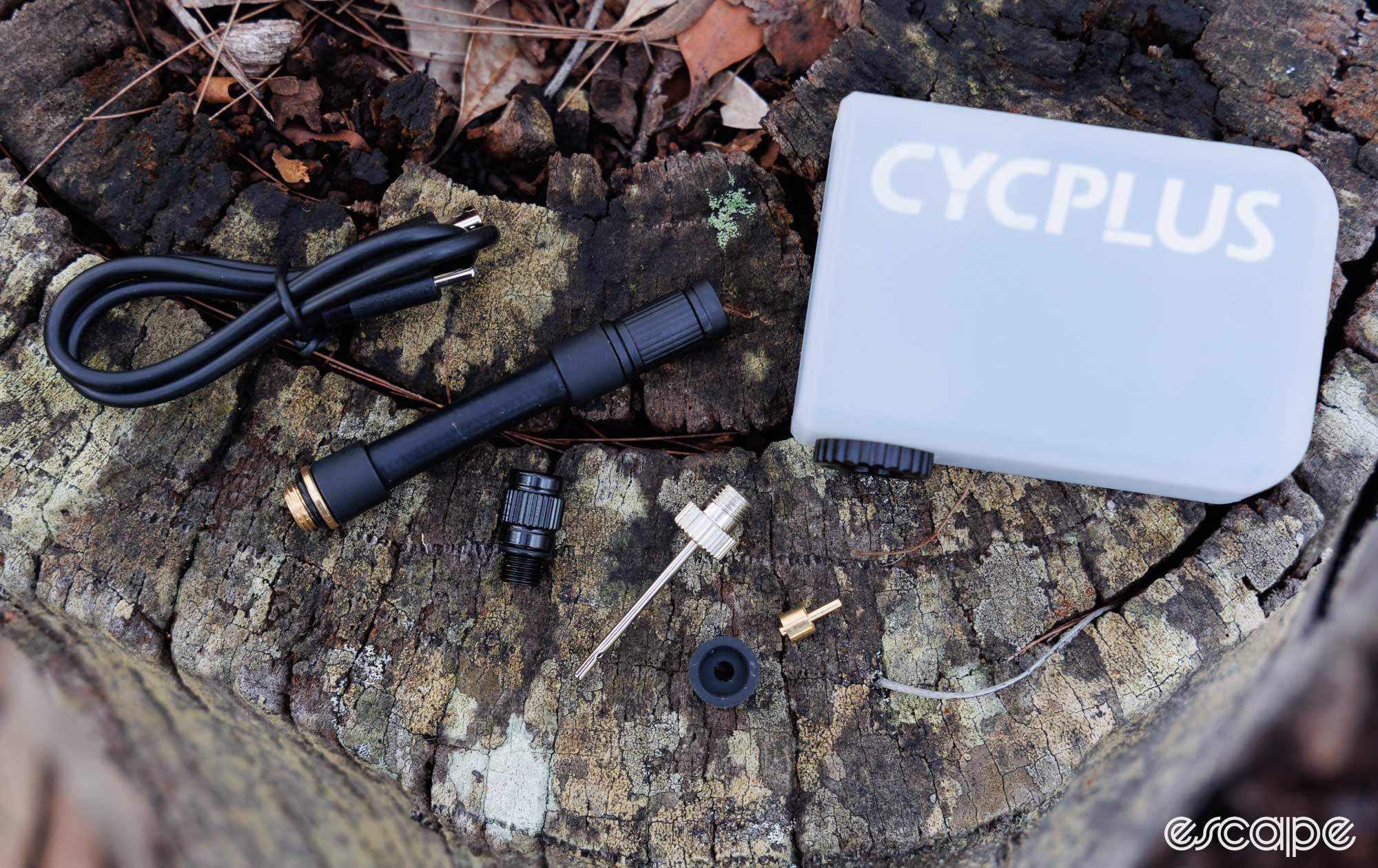
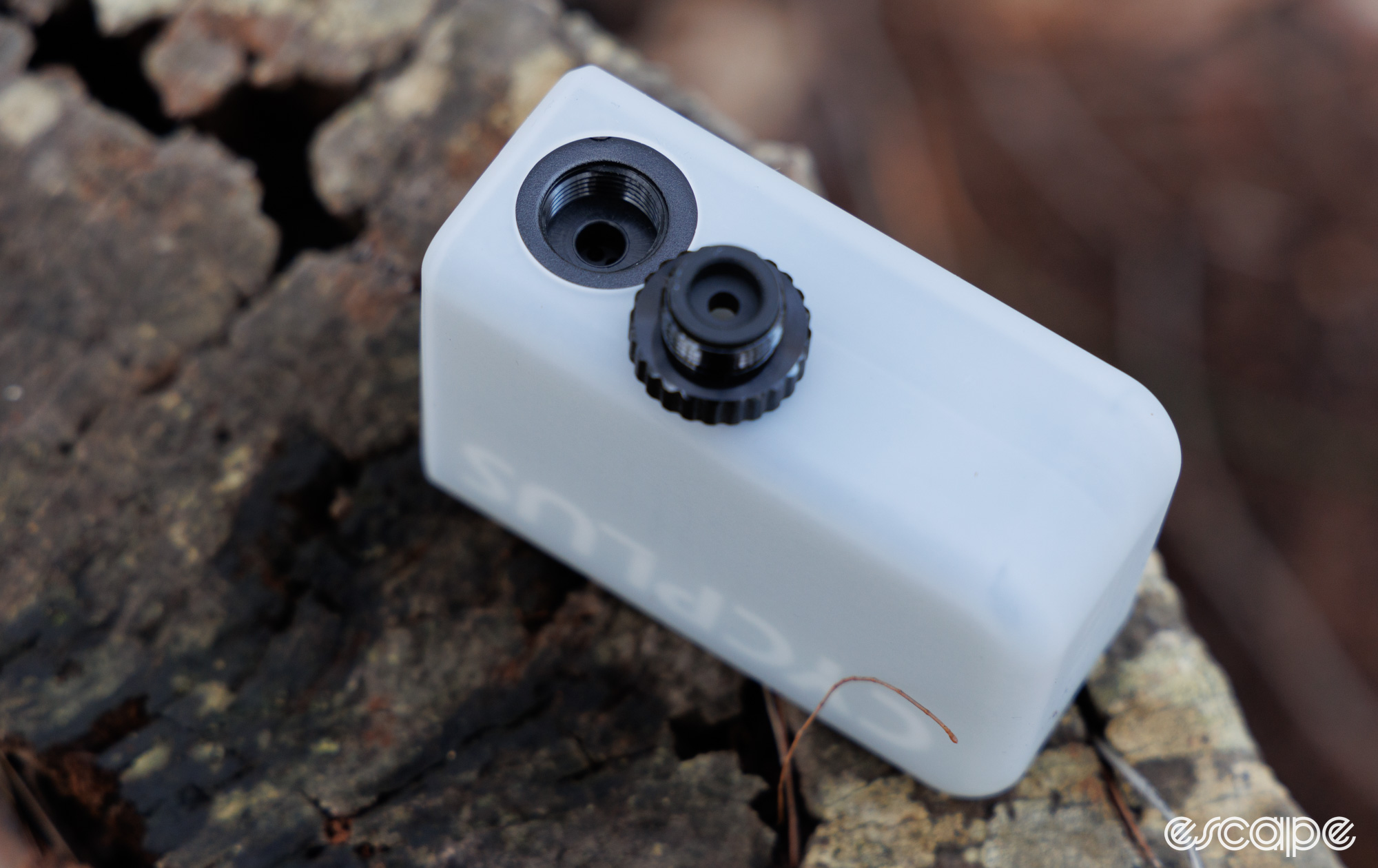
All of the pumps covered here can be used with either Schrader or Presta valves. However the press-on head design used by Fumpa, and largely copied by Cycplus, is a bit more set-and-forget and requires a small brass part (provided in the box) to be added for Schrader.
Ideally, the inflator doubles as a trustworthy gauge, and so once you’ve topped up your tyres, you’re good to roll. In this sense, if an inflator offers a pressure gauge, then I’d argue it’s useless if not at least decently accurate. Generally speaking and from my testing, most gauge-equipped inflators are surprisingly good in terms of accuracy and consistency, and in this regard, they’re superior to most analogue gauge floor pumps. Absolute gauge accuracy matters less if it’s the only gauge you ever use, but it’s still something to keep in mind.

Speaking of gauges, all but the Fumpa and basic Cycplus AS2 have the ability to preset pressure and have the auto-stop engage once it's reached. Additionally, of the units with a preset pressure function, all but Milwaukee will remember the preset you last selected, making it a handy feature to have. By contrast, the Fumpa requires you to hold the button down in order for it to inflate, but its impressive speed balances out the lack of features.
All the pumps will cover the gamut of pressures required from fat biking, to mountain biking, to gravel, and through to road. A decent number of the pumps will get a tyre up to 150 psi for track cyclists, but just be warned that doing so will heavily drain the battery. Similarly, many of these pumps can also be used to inflate mountain bike suspension air springs, but pay attention to these maximum pressures and whether they’re suitable.
Every pump tested in the mini-to-medium-size categories is now USB-C rechargeable, and that’s a huge positive over the proprietary plugs of the past. Charging times do vary, but many pumps are fully juiced within an hour or three. That USB-C charging makes these pumps easy to live with and a sensible choice for travel.
Speaking of travel, devices with a contained battery within the mini-to-medium sizes are comparable to an electrical shaver and can therefore be taken as checked baggage or as carry-on (double check the requirements of your airline).
Most of these inflators are considered non-serviceable and so may add to landfill in the future. This is one area where the Australian-based Fumpa retains a clear advantage through selling replacement batteries and being a business you can send things back to for service (arguably only useful for those in Australia).
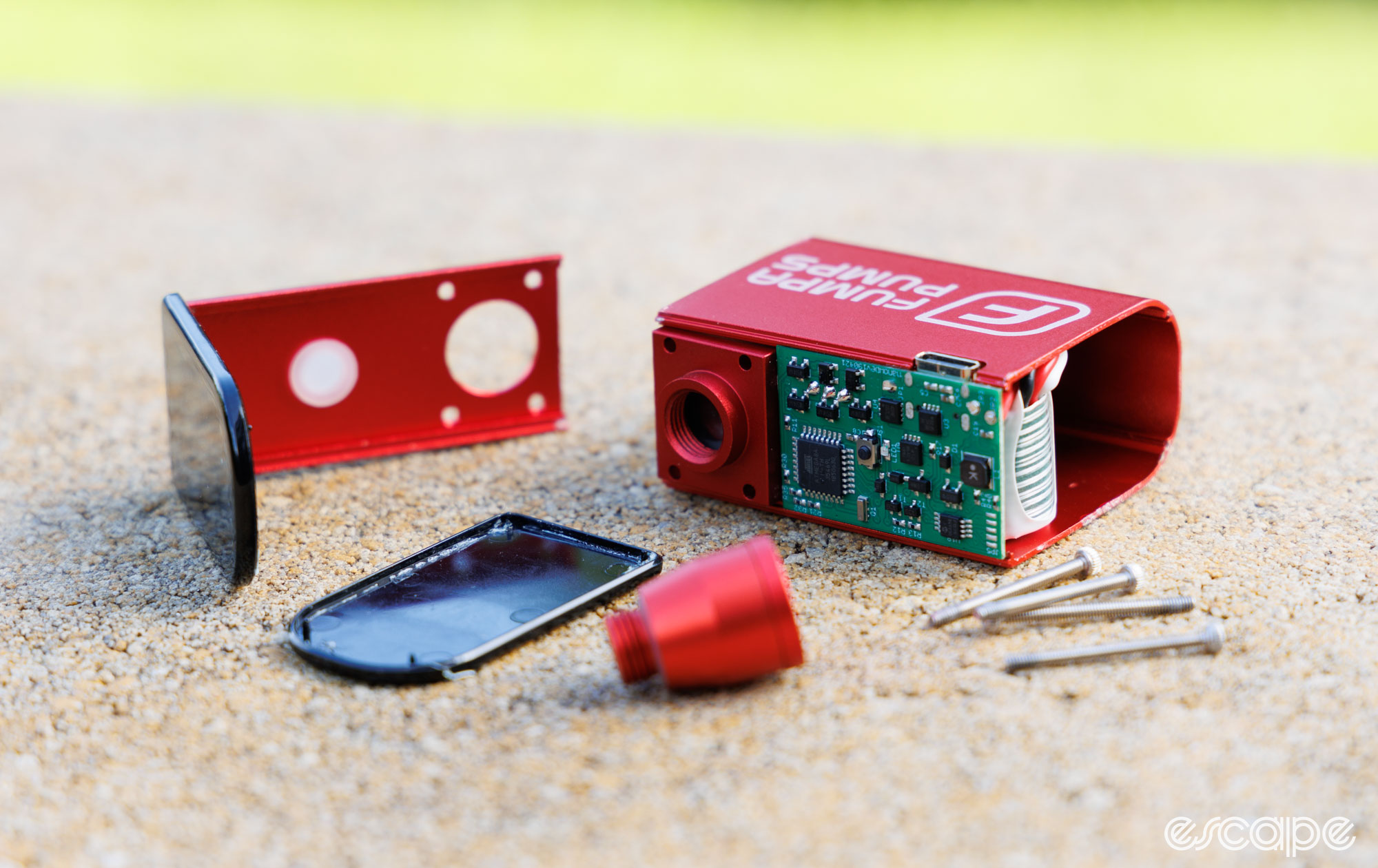
What’s the catch?
There’s a lot to like in some of these inflators, but there’s one big and obnoxious tradeoff to know about – noise. All of these inflators produce noise, and some are downright raucous.
If you live in a household where you need to sneak out for a morning ride, then the humble floor pump is likely still your best option. Similarly, driving to a peaceful car park for an early morning mountain bike ride and letting one of these rip may upset the locals.
Beware the noise...
There seems to be a close correlation between the speed at which one of these cordless inflators works at, and the perceived noise they emit. I’ve included some noise level figures to consider, but I question the accuracy of the instrument used as the figures measured don't always align with perceived noise.
The vibration from many of these inflators is less of an issue but one worth noting. If you’re known to be sensitive to such things (such as from previous injuries), then you should look for one that offers both a hose attachment and preset pressure setting so you can be hands-free.
Many of these units create a fair bit of heat and that has been known to cause issues with the plastic valve stems found on lightweight TPU tubes (such as Tubolito). This is only an issue experienced with direct-fit pump heads, while anything with a hose will do a decent job of isolating the heat.
Then there’s the glaring issue that none of these inflators are waterproof by any means. It’s arguably only a concern for the mini to small inflators that are likely to be taken on a ride, and these options do now include a small ziplock baggy or similar as a bandaid solution.
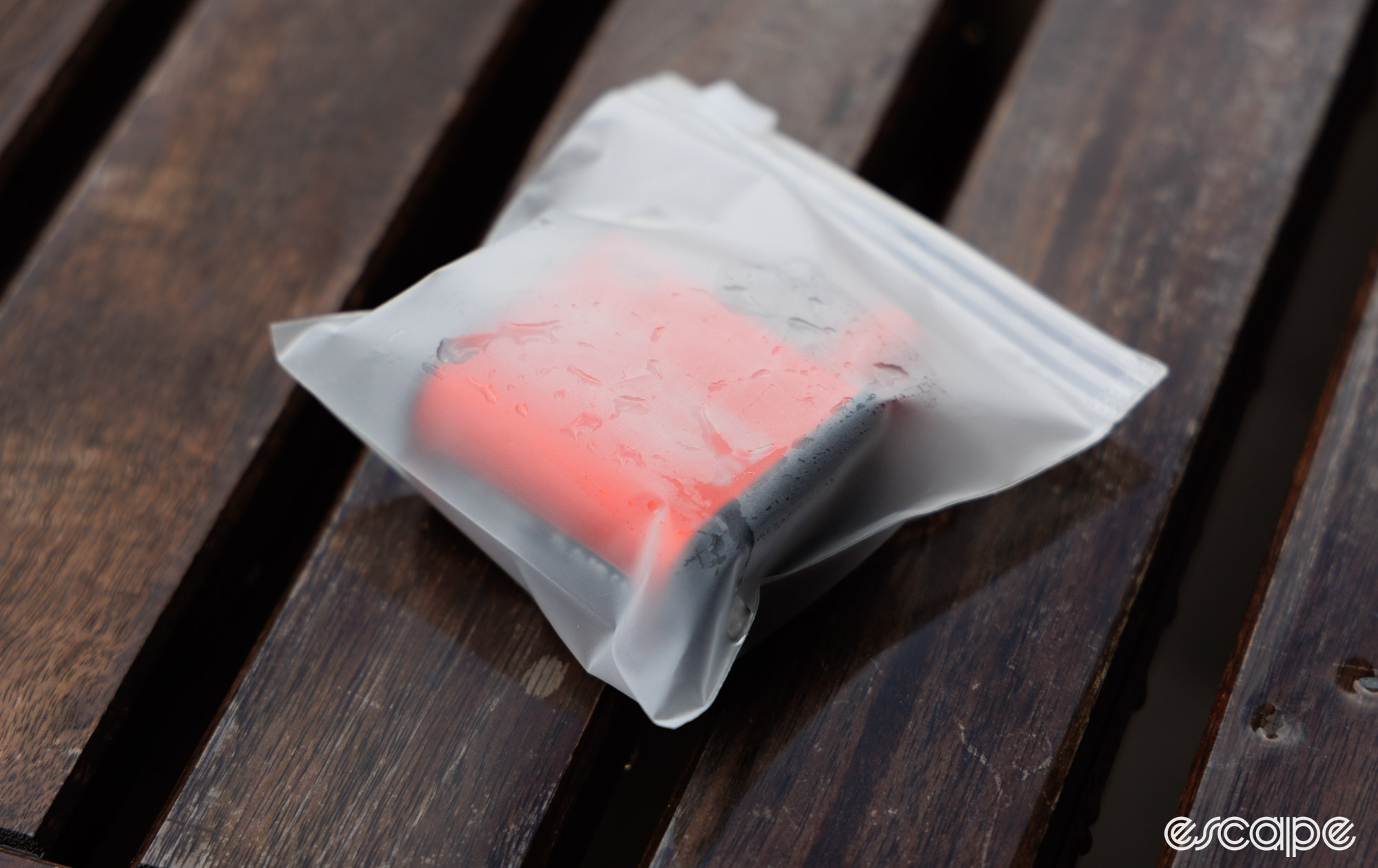
Finally there’s the obvious element that these devices do require recharging. Leaving a mini inflator in your saddle bag for a year may see the battery dwindle to useless levels for when you actually need it. Similarly, I’ve forgotten to charge my inflator and have had it go flat mid top-up just before I need to head out the door. These same struggles exist in all rechargeable battery devices, and it’s wholly understandable if you want fewer things to remember to charge.
The data, how I tested, and endless options
Rather than write endlessly about the features of each pump, I instead decided to distill it into numbers. There’s a whole lot to unpack in the chart below and I still hear the buzzing from the hours spent putting this data together.
| Product | Weight (g) | Dimensions (mm) | Size category | Price (USD) | Time to 80 psi (700 x 28 mm tyre) | Time to 25 psi (29 x 2.6″ tyre) | Inflations of a 29 x 2.6″ tyre | Inflations of 700 x 28 mm tyre | Actual pressure at device 25 psi / 80 psi | Decibels at 20 psi | Actual Max Pressure (psi) |
| NanoFumpa | 98 | 58x66x28 | Mini | $99 | 1 min 40 seconds | 2 min 48 seconds | 1.8 | 2.6 | No Gauge | 83 | 93 |
| Cycplus AS2 | 119 | 67x48x31 | Mini | $89 | 1 min 45 seconds | 2 min 26 seconds | 1.48 | 1.96 | No Gauge | 88 | 102* |
| Cycplus AS2 Pro | 137 | 73x50x31 | Mini | $109 | 53 seconds | 1 min 33 seconds | 3.16 | 4.5 | 23.6 / 79.2 | 86 | 120 |
| Cycplus AS2 Pro Max | 231 | 83x61x35 | Small | $129 | 35 seconds | 1 min 05 seconds | 6.76 | 8.8 | 23.2 / 78.9 | 86 | 119 |
| Fumpa | 375 | 89x93x44 | Small | $149 | 24 seconds | 55 seconds | 3.52 | 7.75 | 25.4 / 80.1 | 89 | 120 |
| QiCycle Bike Pump Mini | 386 | 107x77x38 | Small | $60 | 1 min 28 seconds | 2 min 34 seconds | 11.98 | 13.87 | 25.3 / 80 | 91 | 150 |
| QiCycle N3 | 434 | 188x74x46 | Medium | $60 | 44 seconds | 1 min 28 seconds | 15.28 | 22.68 | 25.2 / 80 | 95 | 150 |
| Mojietu Electric Inflator Pump | 494 | 205x70x70 | Medium | $50 | 1 min 28 seconds | 2 min 40 seconds | 12.32 | 16.85 | 26.9 / 79.2 | 89 | 153 |
| Bosch EasyPump | 421 | 270x100x49 | Medium | $85 | 1 min 21 seconds | 2 min 09 seconds | 9.76 | 9.56 | 24.8 / 80.7 | 93 | 151 |
| Milwaukee M12 Compact Inflator | 1,601 | 190x165x145 | Large | $95 (no battery) | 22 seconds | 43 seconds | 9.88 | 14.94 | 22.2 / 79 | 93 | 122 |
*Cycplus AS2 suffered from a smoking smell during the max pressure test.
The controlled tests were conducted with two different wheel/tyre setups to replicate different high-volume (off-road) and high-pressure (road) needs. Testing each pump’s capacity off a single charge proved to be truly maddening, but the longevity is useful information. The numbers here represent the number of full inflations to the specific pressures, with figures after the decimal point being a percentage of how much pressure was achieved in the final inflation before cutting out.
The time to 25 psi is based on filling a 29 x 2.6" tyre, while the time to 80 psi is based on a 700 x 28 mm tyre. You may be wondering how these inflation speeds compare to a floor pump, and the results may surprise you. Using a Lezyne CNC Floor Drive HP, I inflated the 700 x 28 mm tyre to 80 psi in 18 seconds, and the 29 x 2.6" tyre to 25 psi in 38 seconds. To be fair, I gave it a proper go, and both of these felt like interval training, but it does prove that a good floor pump can be wonderfully efficient. Still, to top up pressures before a ride, the better electric inflators are faster simply because they do not lose much air to backfill and you're not having to move far between the valve and the pump.
Meanwhile you may be wondering how some of the mini inflators compare to a decent hand pump in case of road/trail-side repair. Quite simply, with an electric inflator you won’t end up exhausted or frustrated (unless you get enough flats to flatten the battery). And compared to CO2, it won't be as fast, but is arguably less wasteful and lower stress in that you don’t need to get it right on the first go.

As mentioned previously, this category is heating up, and it feels like a new option is added to a corner of the internet every few days. Topeak just announced its entry (not available for sale, yet), and a big full-service bike brand is rumoured to have one on the way, too. Then we have the many generic options, such as Hoto, Fanttik, and RockBros (these latter two are manufactured by QiCycle, as are the latest pumps sold under the Xiaomi name).
By keeping the test protocol the same, my goal is to be able to test and directly compare other options as I get my hands on them.
The best ride-friendly mini inflators
It was just a year ago that I compared the only two truly miniature inflators on the market, the NanoFumpa versus the Cycplus AS2, and things have progressed quickly since then.
While keeping in mind that new options continue to become available (and some patent disputes may arise), the new Cycplus AS2 Pro has truly impressed me by combining an impressively small form factor with the useful gauge of a larger inflater. Yes, it's a bit bigger than the original Cycplus AS2 and nanoFumpa, but that increased form factor brings real benefit.
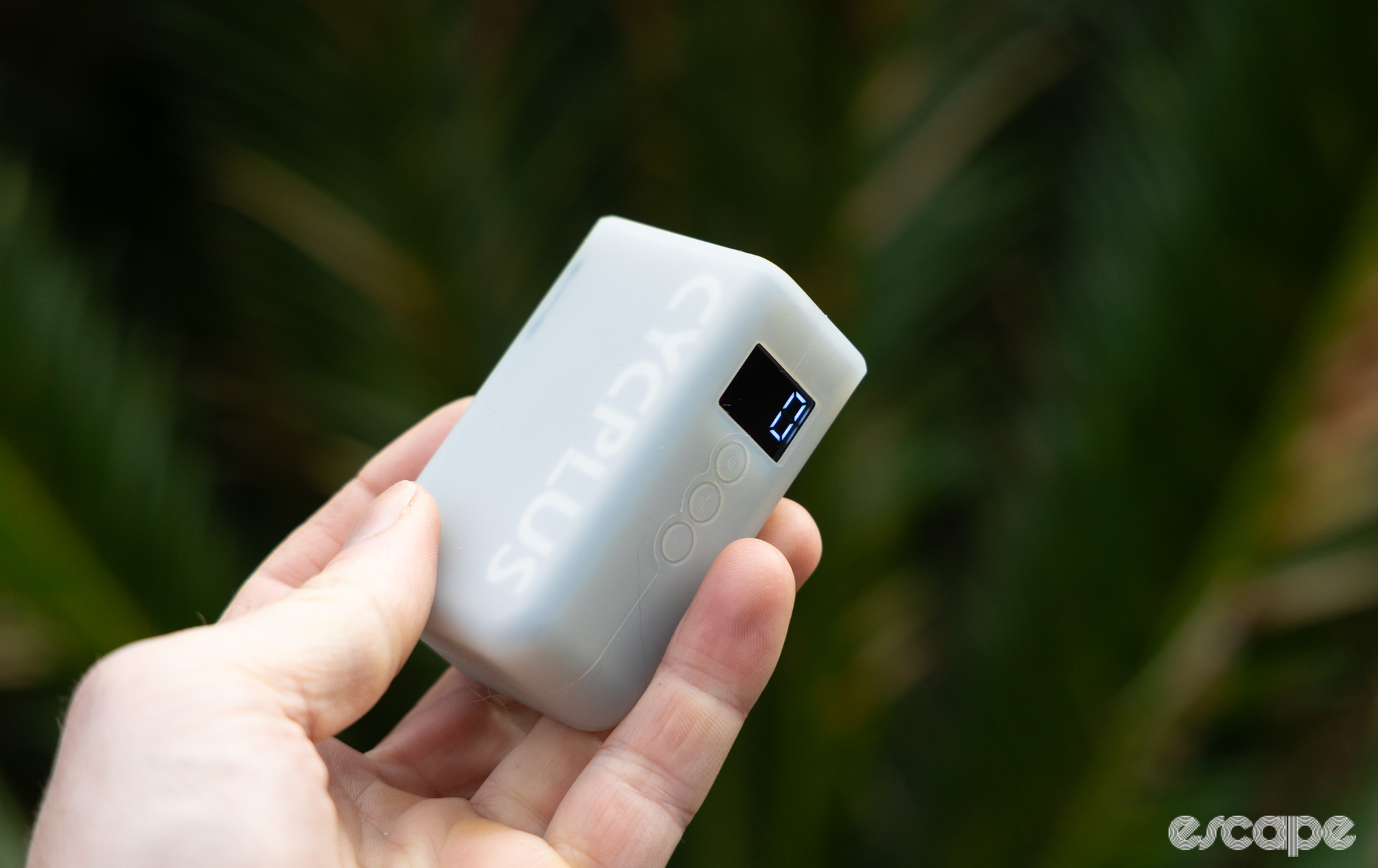
In this sense, the AS2 Pro could double as a general pre-ride inflator and it would certainly be a great choice as a travel pump in place of both a floor pump and mini pump. This pump offers an impressive amount of oomph for its size.
However, it's not quite perfect. The gauge on my sample read a touch low at lower pressures. Due to the heat created, you’ll also want to use the provided threaded hose-based valve head if inflating plastic valve stems (like those on many TPU tubes).
If your priority is absolute tinyness over features such as a gauge, then the nanoFumpa still wins on the scales. Its application is more limited, but gosh it is cute.
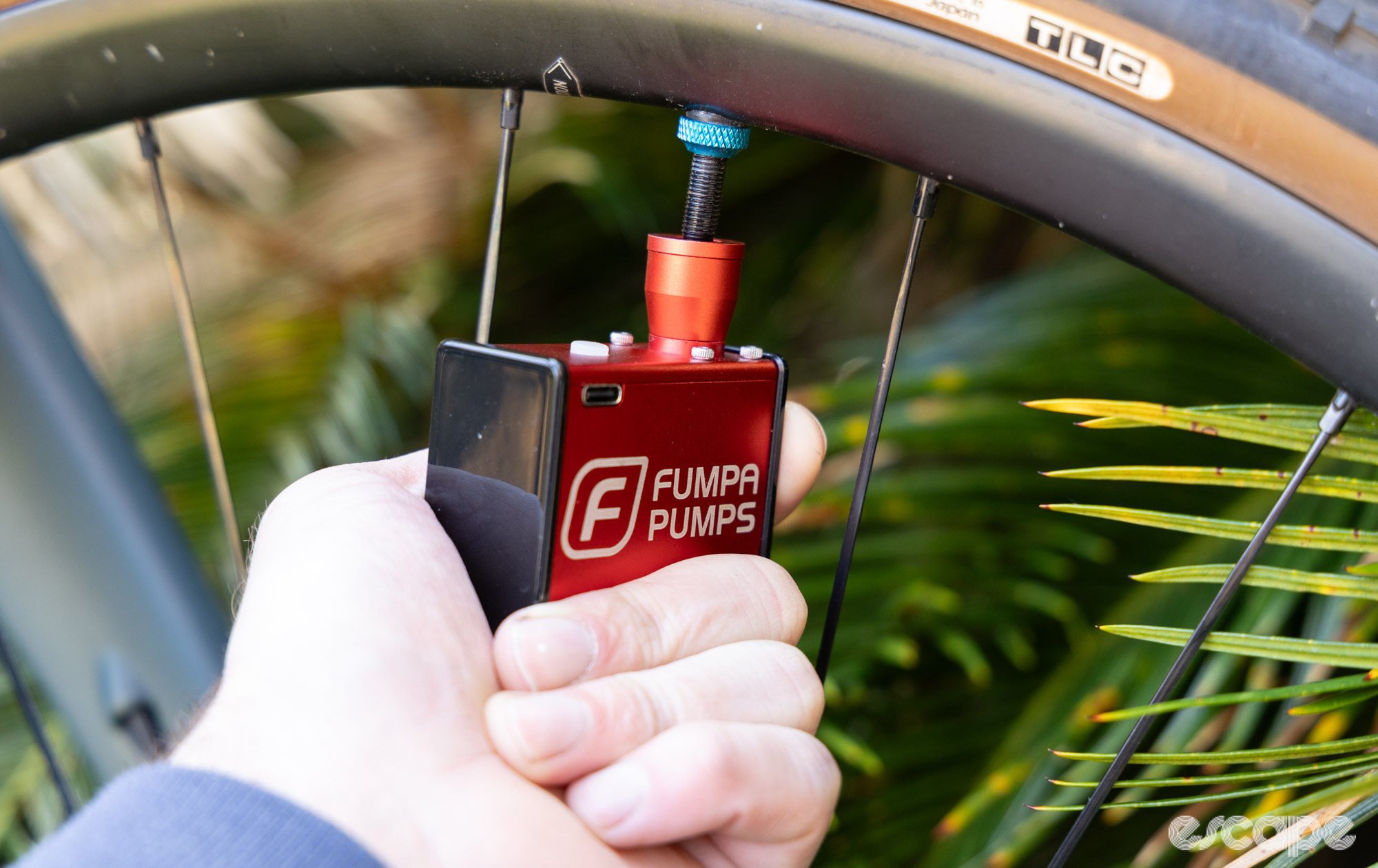
Despite all that's good in this category, my personal feelings about these pumps haven’t changed in recent years. I still set up bikes with dedicated flat repair kits and so prefer the set-and-forget nature of CO2 and/or a mini pump. Still, if I’m packing a handlebar bag or riding pack to ride with a group, I’ll be chucking in the AS2 Pro (in a sealed baggy) as my community service.
The best small to mid-size inflators
My floor pumps have largely collected dust for a number of years since I first started using the first generation of Fumpa. Through this latest round of testing, the simple press-on-push-the-button-and-go functionality, speed of inflation, and gauge accuracy have only further cemented the Fumpa as my top choice.
This isn’t to say the Fumpa is perfect. It’s a noisy bugger. It has high vibration, requires more frequent recharging (although the numerical-based battery gauge is great), and has no preset pressure functionality. Its rapid inflation also causes spiking in the gauge, and so you’ll need to wait a second for pressures to settle upon releasing the go button. This can cause a little off-and-on trigger action before landing on your ideal pressure. Still, the extra time taken with this settling of pressures and adjusting for it is included in the listed inflation times – further showing how rapid the surprisingly compact Fumpa is.
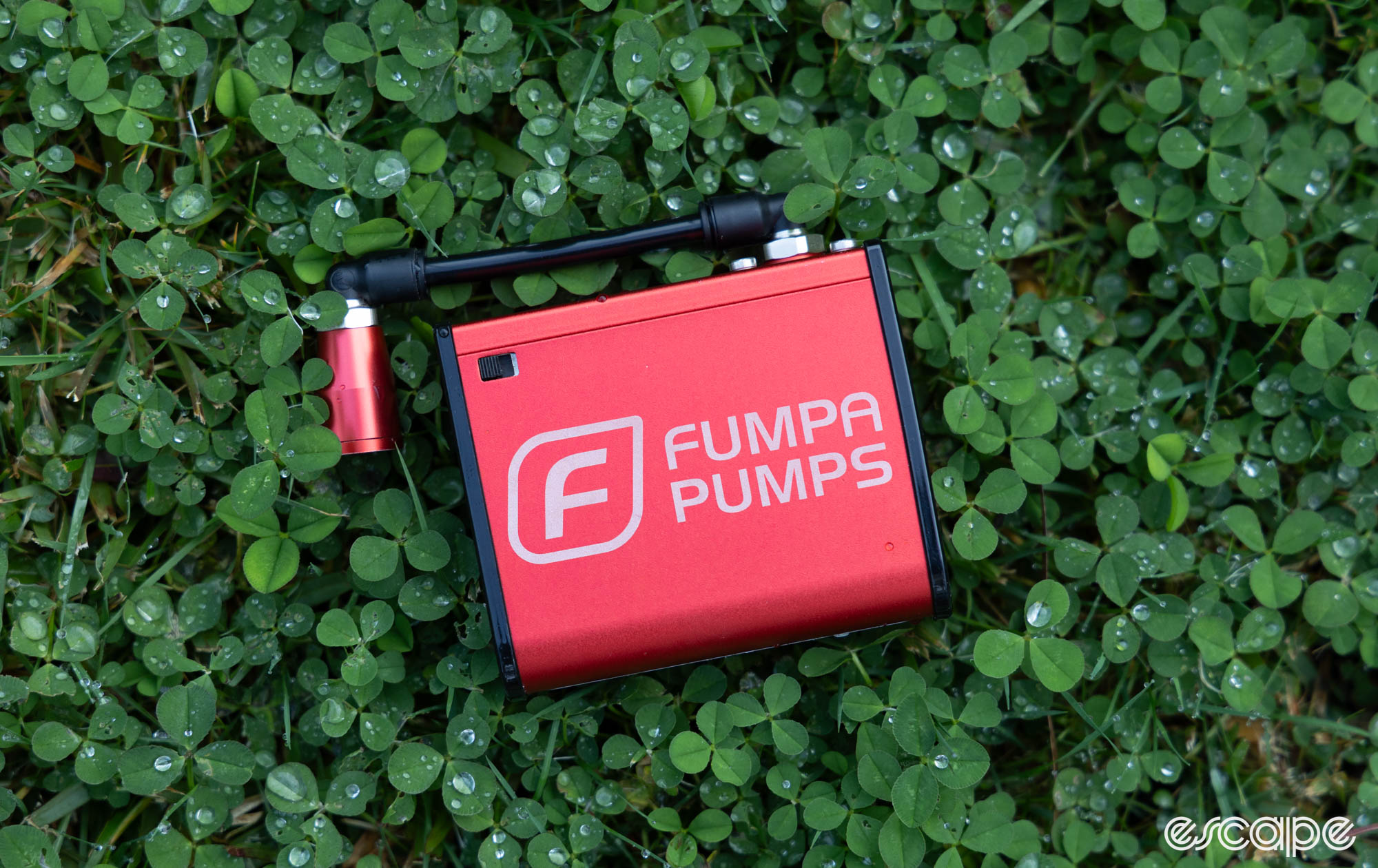
The Fumpa now comes stock with a direct-fit valve to save space, but I greatly prefer it with the shown Elbow Nozzle Kit (US$19 extra). I’ve found this extension to greatly reduce vibration, make it easier to hold, save heat from going directly into your valve stem, and it seemingly makes it less sensitive to pressure spikes, too.
By contrast, the speed of many other pumps had me missing the speed of a good floor pump – I’m impatient like that. I also see a push-on valve head as an absolute must for efficiency, and so if your pump of choice has a threaded head, then consider getting a push-on Presta adapter from the likes of Presta Cycle, Arundel, or Silca (a topic for a future Threaded!).
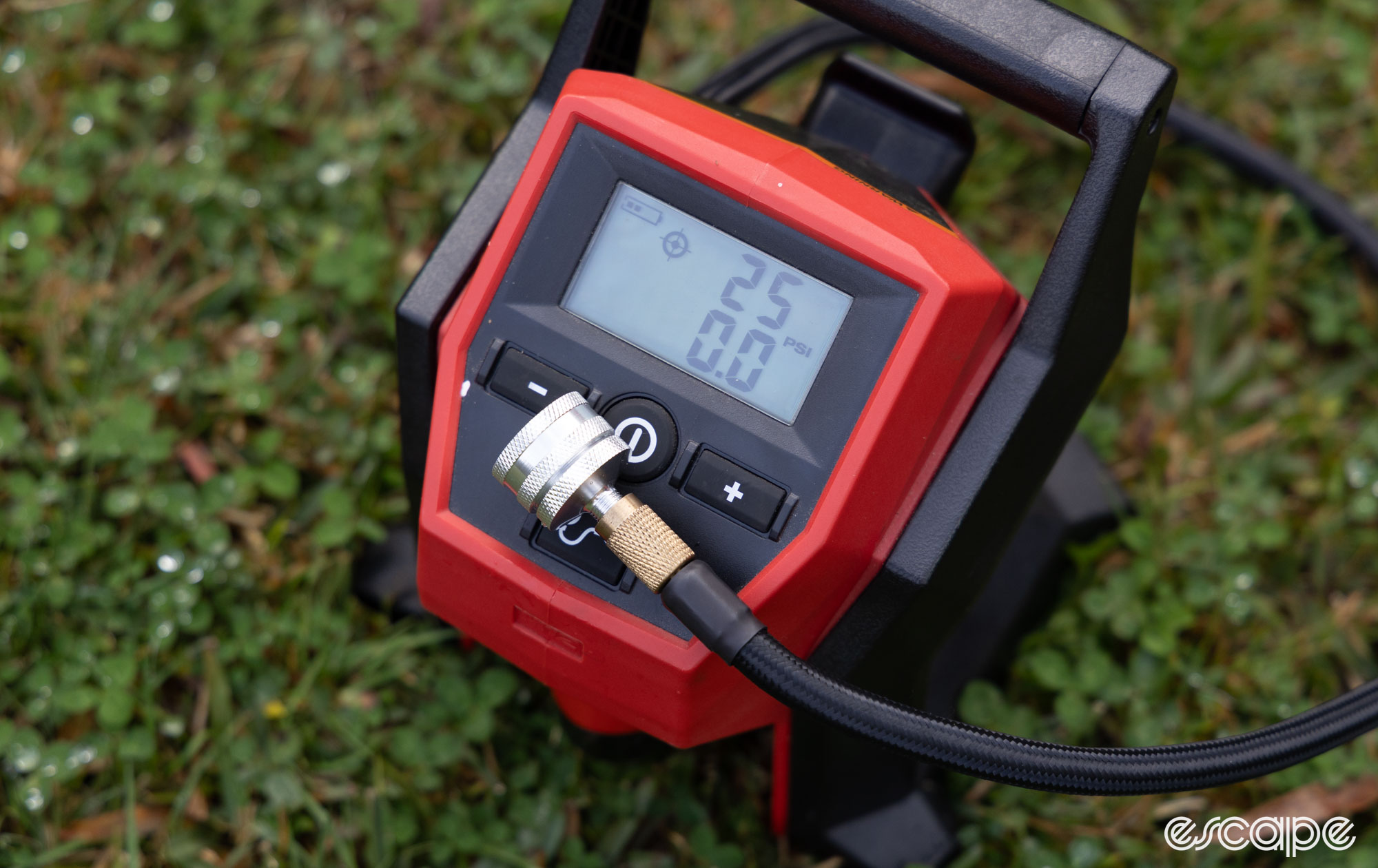
My second pick would be the Cycplus AS2 Pro Max. However, its less-accurate gauge and slower fill speed are enough for me to want to spend more for the original Fumpa.
Lastly, I was really impressed by the QiCycle Bike Pump Mini for how many tyre fills it managed, its gauge accuracy, its simple form factor, its generally quieter/less-buzzy running, and the price at which it does it all at. The valve head is threaded, but it's the nicest execution of such things. This is a lovely budget option if you’ve got the patience for its sluggish fill speed.
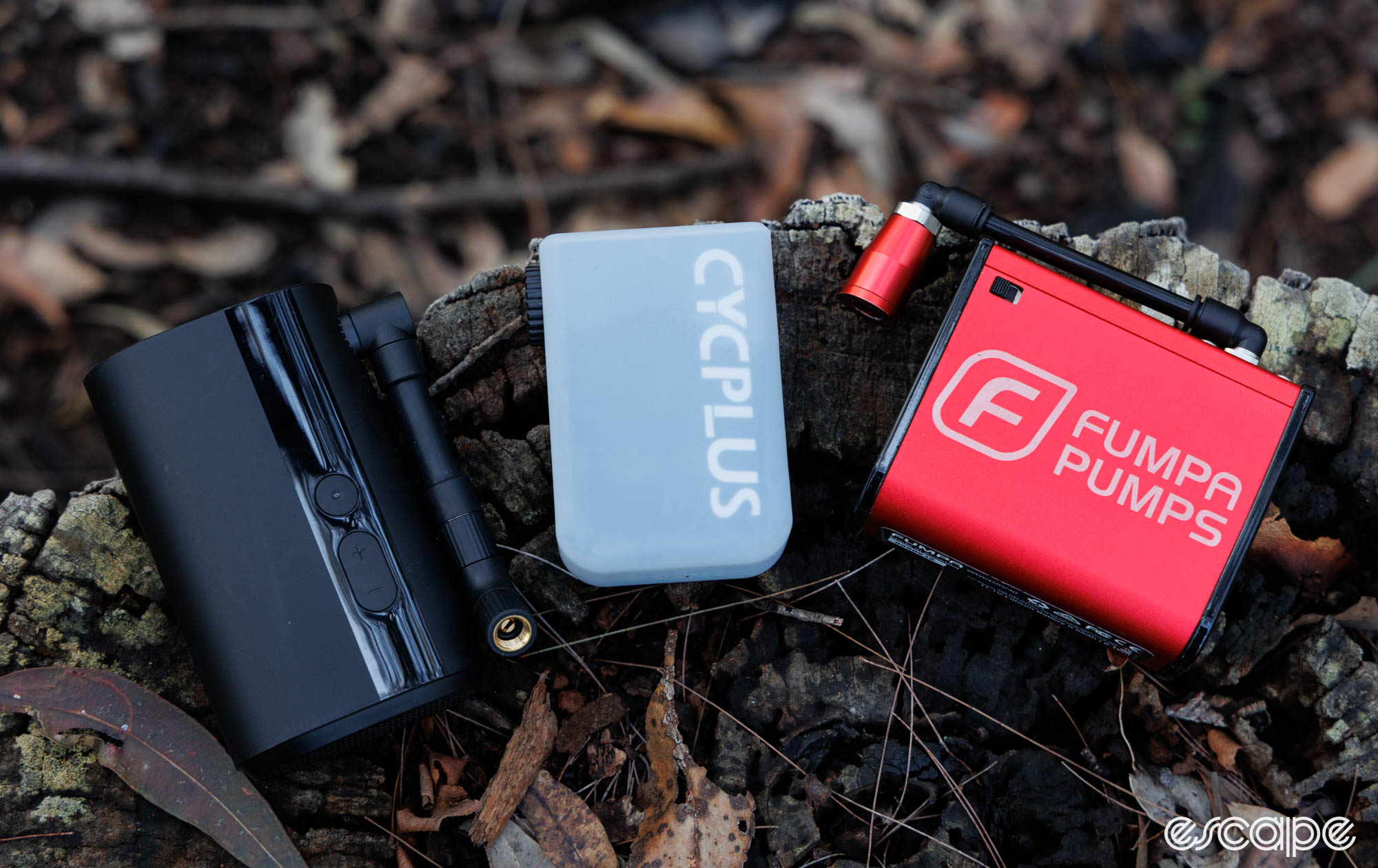
Best large size inflators
Larger inflators were not the purpose of this Threaded and so I don’t have a recommendation to share. Do keep in mind inflators of this size are teetering on the edge of being too large to chuck in a bag or suitcase.
Though admittedly, even a more compact version like the Milwaukee tested (there are many vastly more powerful options) offers a compelling speed of inflation and ability to swap out batteries. Those features will make the additional size worthwhile if inflating tyres for multiple riders (or wanting something for the car tyres, too). Still, battery-powered air compressors with a fill tank can be had for not a lot more, and offer far wider functionality for many users.
Never done
Perhaps the most notable finding of this test was how reliable and easy-to-use all of these pumps are. Often, in group tests, I discover one or two products that are bordering on junk, but from what was tested here, there are no must-avoids. Sure, some will require you to have the patience of a saint and time to waste (I'd rather use a floor pump than many of the slower options), but they’re at least up to the intended task.
This product category is receiving increasing attention, and I’m willing to bet that it will soon become saturated with generic options that don't offer anything unique and may even detract from those pushing the boundaries. Still, I'm optimistic that we'll see inflators that are even faster, more efficient, and just generally better than what's available today.
It’s a convenience-based product category, and I’ll be the first to admit that there will always be a place for a good floor pump and mini pump. Still, if you’re in the market for a new pressure gauge and/or way to inflate tyres, and the noise isn’t a deal-breaker, it’s well worth looking here.
Did we do a good job with this story?

